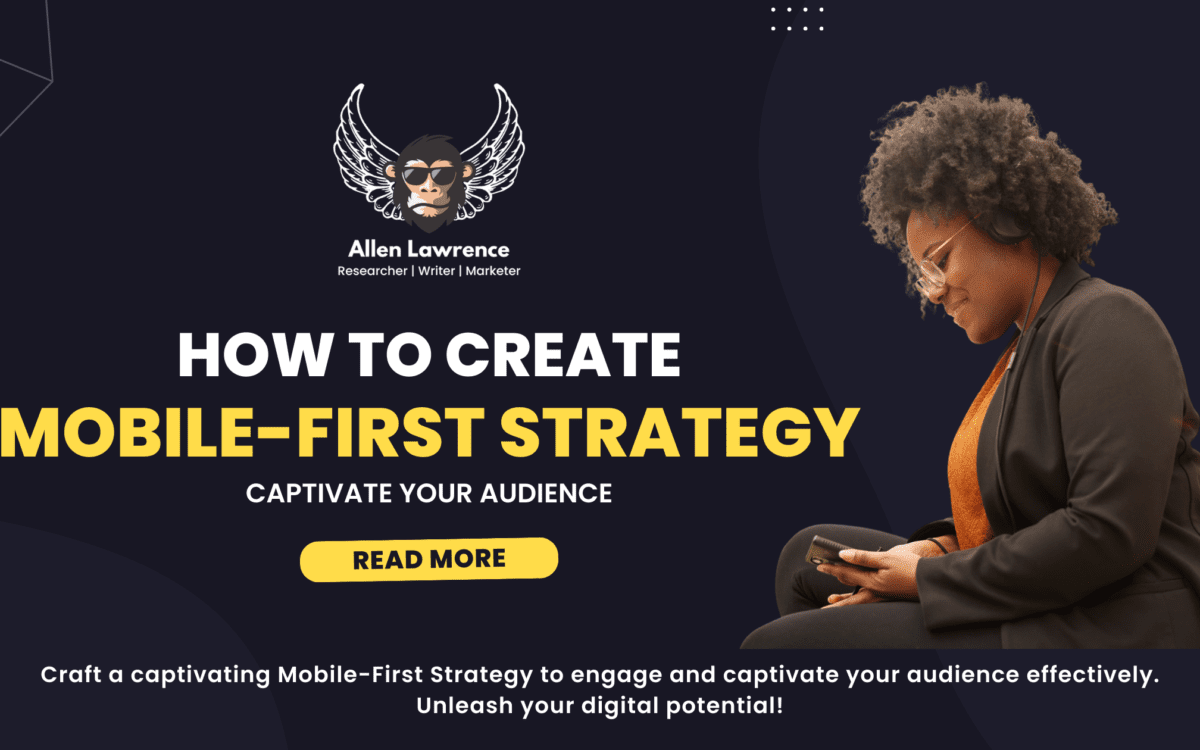I. Introduction
In today's digital landscape, mobile devices have become an integral part of our lives. People are increasingly relying on their smartphones and tablets to access information, connect with others, and make purchasing decisions. As a result, businesses need to adopt a mobile-first strategy to effectively engage their audience and stay ahead in the competitive online market.
A. Importance of Mobile-First Strategy
Implementing a mobile-first strategy is crucial for businesses to reach and connect with their target audience. With the growing number of mobile users worldwide, neglecting mobile optimization can lead to missed opportunities and a decline in user engagement. By prioritizing mobile experiences, businesses can enhance their online presence, improve customer satisfaction, and drive conversions.
B. Understanding Audience Engagement
To effectively engage your audience, it's essential to understand their needs, preferences, and behaviors. By gaining insights into their mobile usage patterns and expectations, you can tailor your mobile-first strategy to deliver a seamless and captivating experience. This article will explore various tactics to help you master the art of mobile-first strategy and create impactful interactions with your audience.
II. Understanding Mobile-First Strategy
A. Definition and Concept
A mobile-first strategy refers to designing and optimizing digital experiences primarily for mobile devices before considering desktop or other platforms. It involves creating responsive and mobile-friendly websites, applications, and content to ensure a consistent and enjoyable experience across different screen sizes.
B. Key Benefits of Mobile-First Approach
Embracing a mobile-first approach offers several advantages for businesses:
- Improved User Experience: By focusing on mobile optimization, businesses can provide users with faster load times, intuitive navigation, and visually appealing interfaces, resulting in enhanced user satisfaction.
- Higher Search Rankings: Mobile-friendly websites are favored by search engines, leading to better visibility and improved organic rankings.
- Increased Conversion Rates: With a seamless mobile experience, businesses can streamline the conversion process and reduce friction, resulting in higher conversion rates and improved sales.
- Competitive Advantage: A well-executed mobile-first strategy can differentiate your brand from competitors, positioning you as an industry leader with a strong online presence.
C. Mobile Usage Statistics
Understanding mobile usage statistics can provide valuable insights into the prevalence and importance of mobile devices in today's digital landscape. Consider the following statistics:
- As of 2021, there are over 5.27 billion unique mobile phone users worldwide.
- Mobile devices account for approximately 54% of global website traffic.
- The average person spends around 4.2 hours per day on their mobile device.
- Mobile searches have surpassed desktop searches, making mobile optimization crucial for search engine visibility.
III. Conducting Audience Research
Before diving into mobile-first strategy implementation, it's essential to conduct thorough audience research. Understanding your target audience and their mobile behavior will help you create tailored experiences that resonate with their needs and preferences.
A. Identifying Target Audience
Define your target audience based on demographics, psychographics, and other relevant factors. Consider their age, gender, location, interests, and mobile device usage patterns. This information will enable you to personalize your mobile strategy and deliver content that appeals to their specific preferences.
B. Analyzing User Behavior
Leverage analytics tools to gather insights into user behavior on your website or mobile app. Track metrics such as bounce rates, session duration, and conversion rates to identify areas for improvement. Analyzing user behavior will help you optimize your mobile experience and maximize engagement.
C. Defining User Personas
Creating user personas can further enhance your understanding of your audience. Develop fictional representations of your target users, including their goals, challenges, and motivations. By empathizing with your user personas, you can tailor your mobile-first strategy to address their specific pain points and deliver a personalized experience.
IV. Crafting Compelling Mobile Content
Creating high-quality and engaging mobile content is a crucial aspect of a successful mobile-first strategy. Optimize your content to ensure it is accessible, visually appealing, and easy to consume on mobile devices.
A. Content Optimization for Mobile Devices
- Responsive Web Design: Implement responsive design principles to ensure your website adapts seamlessly to different screen sizes, providing an optimal viewing experience for mobile users.
- Mobile-Friendly Formatting and Layouts: Use shorter paragraphs, bullet points, and headings to enhance readability on smaller screens. Prioritize important information and make it easily scannable.
- Optimized Media and Visuals: Compress images and videos without compromising quality to minimize load times. Use alt tags to provide alternative text descriptions for screen readers and improve accessibility.
B. Engaging Headlines and Subheadings
Craft compelling headlines and subheadings that grab the attention of mobile users. Use concise and impactful language to communicate the value of your content, making users more likely to engage and continue reading.
C. Incorporating Relevant Keywords
Research and include relevant keywords in your mobile content to optimize it for search engines. Identify long-tail keywords with mobile intent to capture specific user queries and increase your chances of ranking higher in search results.
D. Utilizing Visual and Interactive Elements
Enhance user engagement by incorporating visually appealing elements such as images, videos, infographics, and interactive features like quizzes or surveys. Visual content is highly shareable and can help increase your brand's visibility and reach.
V. Mobile User Experience (UX) Design
A seamless and intuitive user experience is paramount in a mobile-first strategy. Prioritize mobile UX design to ensure users can navigate your website or app effortlessly, leading to increased engagement and conversions.
A. Simplified Navigation and Intuitive Interfaces
Streamline your mobile navigation by using intuitive icons, clear menus, and a logical hierarchy. Minimize the number of clicks required to access important information, reducing user frustration and improving overall satisfaction.
B. Fast Load Times and Performance Optimization
Mobile users expect instant access to information, so optimize your website or app for speed. Compress images, leverage caching techniques, and minimize unnecessary scripts to improve load times. Test your mobile experience across different devices and network conditions to ensure optimal performance.
C. Seamless and Efficient User Journeys
Design user journeys that guide visitors through your mobile experience seamlessly. Optimize conversion funnels, provide clear calls to action (CTAs), and minimize form fields to simplify the user journey and encourage desired actions.
VI. Leveraging Mobile SEO
To maximize the impact of your mobile-first strategy, it's crucial to optimize your mobile presence for search engines. Mobile SEO techniques will help improve your website's visibility and attract organic traffic.
A. Mobile-Friendly Website Structure
Ensure your website has a responsive design and a mobile-friendly structure. Use proper HTML markup, avoid interstitials that hinder user experience, and enable Google's mobile-friendly test to assess your site's compatibility.
B. Optimizing Page Speed and Performance
Monitor and improve your mobile page speed by minimizing server response time, leveraging browser caching, and reducing unnecessary redirects. Compress and optimize images, enable lazy loading, and utilize AMP (Accelerated Mobile Pages) to enhance performance.
C. Mobile Indexing and Crawling
Ensure that search engine crawlers can access and index your mobile content. Verify the mobile version of your website with Google Search Console and use mobile-specific sitemaps to facilitate crawling and indexing.
VII. Mobile Advertising and Marketing Strategies
Mobile advertising and marketing play a crucial role in reaching your target audience and driving conversions. Implement effective mobile strategies to increase brand visibility and engage mobile users.
A. Mobile Advertising Platforms
Leverage mobile advertising platforms such as Google Ads, social media ads, and in-app advertising networks to target specific demographics, interests, and locations. Use precise targeting options to maximize the effectiveness of your mobile ad campaigns.
B. Mobile App Install Campaigns
If you have a mobile app, invest in app install campaigns to increase downloads and user acquisition. Utilize app store optimization (ASO) techniques to optimize your app's visibility in app store search results.
C. Location-Based Targeting
Leverage location-based targeting to deliver relevant and personalized mobile ads to users based on their geographical location. Geo-targeting allows you to tailor your messaging and promotions to specific regions, driving higher engagement and conversions.
D. SMS and Push Notifications
Implement SMS marketing and push notifications to engage with your mobile audience directly. Craft compelling and personalized messages to keep users informed about promotions, updates, or exclusive offers.
E. Mobile-Specific Social Media Strategies
Develop mobile-specific social media strategies to effectively engage with your audience on popular mobile platforms. Create mobile-friendly content, leverage stories and live videos, and encourage user-generated content to foster engagement and build brand loyalty.
VIII. Harnessing the Power of Mobile Apps
Mobile apps offer a unique opportunity to enhance audience engagement and deliver personalized experiences. Leverage the benefits of mobile apps to create meaningful interactions with your users.
A. Benefits of Mobile Apps for Audience Engagement
Mobile apps provide various benefits, including:
- Enhanced Personalization: Apps allow for personalized recommendations, customized content, and tailored experiences based on user preferences and behavior.
- Increased Interactivity: Apps enable the integration of interactive features such as push notifications, gamification, and in-app messaging, fostering higher engagement.
- Offline Functionality: Apps can offer offline access to certain features, ensuring uninterrupted user experiences even in areas with limited connectivity.
B. Designing User-Friendly Mobile Apps
When designing mobile apps, prioritize user-friendly interfaces, intuitive navigation, and seamless interactions. Conduct user testing and gather feedback to continuously improve and optimize the user experience.
C. Implementing App-Store Optimization (ASO)
To increase app visibility and drive downloads, implement ASO techniques. Optimize your app's title, description, screenshots, and reviews to improve its ranking in app store search results.
IX. Measuring and Analyzing Mobile Success
To evaluate the effectiveness of your mobile-first strategy, it's crucial to measure and analyze key metrics. Monitoring and understanding mobile engagement will help you refine your approach and drive continuous improvement.
A. Key Metrics for Mobile Engagement
Track the following metrics to gauge mobile engagement:
- Mobile Traffic: Measure the proportion of website traffic coming from mobile devices.
- Bounce Rate: Assess the percentage of users who leave your website or app without taking any further action.
- Session Duration: Measure the average time users spend on your mobile platform.
- Conversion Rates: Track the percentage of visitors who complete desired actions, such as making a purchase or submitting a form.
B. Tracking Mobile Conversions
Implement conversion tracking to attribute mobile conversions accurately. Use tools like Google Analytics or mobile attribution platforms to identify the impact of your mobile-first strategy on conversions and ROI.
C. Analyzing User Feedback
Gather user feedback through surveys, ratings, and reviews to gain insights into their mobile experiences. Address any pain points or suggestions to continuously improve your mobile strategy and exceed user expectations.
X. Summary and Key Takeaways
Mastering the mobile-first strategy is essential for businesses looking to engage their audience effectively and stay competitive in the digital landscape. By understanding your target audience, optimizing your content and user experience, leveraging mobile SEO and advertising, harnessing the power of mobile apps, and measuring mobile success, you can create impactful interactions with your audience and drive meaningful results. Embrace the mobile-first approach, and embark on a journey to captivate and engage your mobile audience with an unforgettable user experience.
XI. Frequently Asked Questions (FAQs)
A. What is a mobile-first strategy?
A mobile-first strategy refers to the approach of designing and prioritizing digital experiences, content, and interfaces specifically for mobile devices before considering desktop or other platforms. It involves creating a seamless and optimized user experience for mobile users, taking into account their preferences, behaviors, and the unique characteristics of mobile devices.
B. How does a mobile-first approach benefit businesses?
Implementing a mobile-first approach offers several benefits for businesses, including:
- Enhanced User Experience: By prioritizing mobile design and usability, businesses can provide a seamless and enjoyable experience for their mobile users. This leads to increased engagement, higher customer satisfaction, and improved brand perception.
- Wider Audience Reach: Mobile devices have become the primary means of accessing the internet for many people worldwide. By optimizing for mobile, businesses can reach a larger audience and tap into the growing mobile user base.
- Improved Search Engine Visibility: Search engines, such as Google, prioritize mobile-friendly websites in their search results. Adopting a mobile-first strategy can improve your website's search engine rankings and visibility, driving organic traffic to your site.
- Increased Conversion Rates: Mobile-optimized experiences are more likely to convert mobile users into customers. By providing a seamless and efficient mobile journey, businesses can improve conversion rates and drive revenue growth.
- Competitive Advantage: In today's mobile-centric world, businesses that prioritize mobile experiences gain a competitive edge. By offering a superior mobile experience, you can differentiate your brand, build customer loyalty, and outperform competitors.
C. How can I optimize my website for mobile devices?
To optimize your website for mobile devices, consider the following best practices:
- Responsive Design: Implement a responsive web design that adapts to different screen sizes and orientations. This ensures that your website looks and functions well on mobile devices.
- Mobile-Friendly Layout: Optimize your website's layout for mobile by using clear and concise content, shorter paragraphs, and larger font sizes. Make sure buttons and links are easily tappable and spaced appropriately for touch interactions.
- Fast Page Load Times: Mobile users expect quick-loading websites. Optimize your website's performance by minimizing file sizes, leveraging caching techniques, and optimizing server response times.
- Streamlined Navigation: Simplify your website's navigation for mobile users. Use intuitive menus, clear icons, and logical organization to help users find information easily.
- Optimized Forms: Mobile forms should be simple and easy to complete. Minimize the number of form fields, utilize autofill options, and use input elements that are optimized for mobile devices.
D. What are some effective mobile marketing techniques?
Effective mobile marketing techniques include:
- Mobile Advertising: Utilize mobile advertising platforms, such as Google Ads, social media ads, and in-app advertising networks, to reach your target audience on their mobile devices. Target specific demographics, interests, and locations to maximize the impact of your mobile ad campaigns.
- Location-Based Targeting: Leverage location-based targeting to deliver personalized and relevant mobile ads based on the user's geographic location. This can help drive foot traffic to physical stores or target specific regions with tailored promotions.
- SMS and Push Notifications: Engage with your audience through SMS marketing and push notifications. Send timely and personalized messages to keep users informed about promotions, updates, and exclusive offers.
- Mobile-Specific Social Media Strategies: Develop strategies that cater specifically to mobile users on popular social media platforms. Create mobile-friendly content, leverage stories and live videos, and encourage user-generated content to boost engagement and brand visibility.
E. How can I measure the success of my mobile-first strategy?
To measure the success of your mobile-first strategy, consider the following metrics and techniques:
- Mobile Traffic and Conversion Rates: Monitor the proportion of website traffic coming from mobile devices and track the conversion rates specifically for mobile users. This data provides insights into the effectiveness of your mobile experience in driving conversions.
- User Engagement: Measure user engagement metrics such as time spent on site, page views per session, and bounce rates for mobile users. Higher engagement indicates that your mobile experience is capturing and retaining user attention.
- App Downloads and Usage: If you have a mobile app, track app downloads, user retention rates, and in-app actions to gauge the success of your mobile app strategy.
- Customer Feedback: Gather user feedback through surveys, ratings, reviews, and user testing. Analyzing customer feedback helps identify areas for improvement and uncovers insights into user satisfaction with your mobile experience.
- Mobile Analytics Tools: Utilize mobile analytics tools, such as Google Analytics or mobile attribution platforms, to gain deeper insights into user behavior, conversion paths, and the impact of your mobile-first strategy on key performance indicators.
Regularly analyze and interpret these metrics to refine your mobile-first strategy, make data-driven optimizations, and ensure continuous improvement in engaging your mobile audience.
Conclusion
Mastering the mobile-first strategy is crucial for businesses seeking to engage their audience effectively and drive sustainable growth in the digital age. By understanding the importance of mobile, optimizing your website and content, implementing effective mobile marketing techniques, and measuring success through relevant metrics, you can stay ahead of the competition and build lasting relationships with your mobile audience. Embrace the mobile-first approach, and unlock the immense potential of the mobile ecosystem to achieve your business goals.




